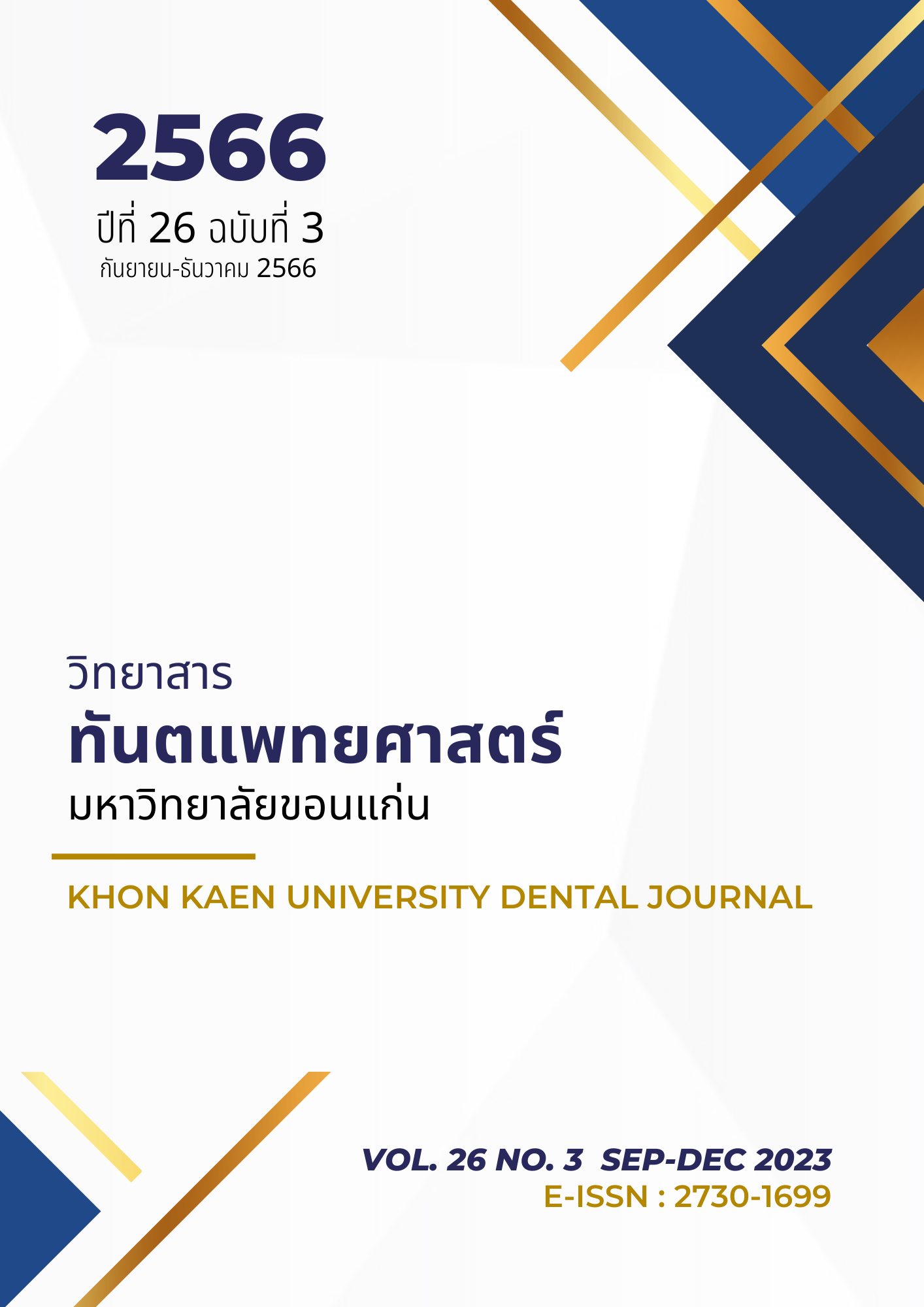ค่าอัตราส่วนขนาดซี่ฟันในผู้ป่วยที่ได้รับการจัดฟันร่วมกับการถอนฟันกรามน้อยซี่ที่หนึ่งสี่ซี่
Main Article Content
บทคัดย่อ
การสบฟัน ระยะสบเหลื่อมแนวราบ ระยะสบเหลื่อมแนวดิ่งที่เหมาะสมระหว่างฟันบนและฟันล่างในผู้ป่วยที่ได้รับรักษาด้วยการจัดฟันร่วมกับการถอนฟันกรามน้อยซี่ที่หนึ่งสี่ซี่นั้น ขึ้นอยู่กับการมีอัตราส่วนร้อยละของขนาดซี่ฟันล่างต่อฟันบนที่เหมาะสม โดยจุดประสงค์ของการศึกษานี้คือ การรายงานค่าอัตราส่วนร้อยละของขนาดซี่ฟันล่างต่อฟันบน และขนาดซี่ฟันแต่ละซี่ในผู้ป่วยที่มีการสบฟันปกติภายหลังการรักษาทางทันตกรรมจัดฟันร่วมการถอนฟันกรามน้อยซี่ที่หนึ่งสี่ซี่ เราคัดเลือกแบบจำลองฟันอย่างเข้มงวดในผู้ป่วยที่ได้รับการรักษาทางทันตกรรมจัดฟันร่วมกับการถอนฟันกรามน้อยซี่ที่หนึ่งสี่ซี่และมีการสบฟันปกติ ดัชนีชี้วัดพาร์ (PAR index) ถูกนำมาใช้เพื่อคัดเลือกแบบจำลองฟันที่มีการสบฟันปกติ หลังจากนั้นนำตัวอย่างที่ผ่านการคัดเลือกจากดัชนีชี้วัดพาร์ทำการประเมินการเอียงตัวของฟันหน้าโดยใช้ภาพรังสีกะโหลกศรีษะด้านข้าง เราคัดเลือกแบบจำลองฟันที่มีการเอียงตัวของมุมฟันหน้าปกติ ได้ตัวอย่างทั้งหมด 38 ตัวอย่าง ตัวอย่างทั้งหมดได้รับการสแกนและวัดขนาดซี่ฟันโดยใช้โปรแกรมแบบจำลองฟันเสมือนทรีเชพ ออโธ ซิสเต็ม (3Shape Ortho System, 3Shape A/S, Copenhagen) เราหาค่าเฉลี่ยของขนาดซี่ฟันแต่ละซี่และ ค่าเฉลี่ยอัตราส่วนร้อยละของขนาดซี่ฟันล่างต่อฟันบน เราพบว่า ค่าเฉลี่ยอัตราส่วนร้อยละของขนาดซี่ฟันล่างต่อฟันบน 10 ซี่ และค่าเฉลี่ยอัตราส่วนร้อยละของขนาดซี่ฟันหน้าล่างต่อฟันหน้าบน 6 ซี่ เท่ากับ 90.31±1.86% และ77.47±2.66% ตามลำดับ นอกจากนั้นยังพบว่าค่าเฉลี่ยขนาดซี่ฟันตัดซี่กลางบน ฟันตัดซี่ข้างบน ฟันกรามน้อยซี่ที่สองบน ฟันกรามซี่ที่หนึ่งบน ฟันกรามน้อยซี่ที่สองล่าง และฟันกรามซี่ที่หนึ่งล่าง มีความแตกต่างอย่างมีนัยสำคัญเมื่อเปรียบเทียบกับการศึกษาที่มีลักษณะคล้ายกัน อีกทั้งเรายังพบความแตกต่างอย่างมีนัยสำคัญของค่าเฉลี่ยอัตราส่วนร้อยละของขนาดซี่ฟันล่างต่อฟันบน10 ซี่ ระหว่างการศึกษาของโบลตัน และการศึกษาของคายาลิโอกลู และการศึกษานี้ โดยสรุปการศึกษานี้แนะนำค่าเฉลี่ยอัตราส่วนร้อยละของขนาดซี่ฟันล่างต่อฟันบน 10 ซี่ เท่ากับ 90.31±1.86% เพื่อใช้ในการวินิจฉัยและวางแผนการรักษาในผู้ป่วยที่วางแผนจะจัดฟันร่วมกับการถอนฟันกรามน้อยซี่ที่หนึ่งสี่ซี่
Article Details

อนุญาตภายใต้เงื่อนไข Creative Commons Attribution-NonCommercial-NoDerivatives 4.0 International License.
บทความ ข้อมูล เนื้อหา รูปภาพ ฯลฯ ทีได้รับการลงตีพิมพ์ในวิทยาสารทันตแพทยศาสตร์ มหาวิทยาลัยขอนแก่นถือเป็นลิขสิทธิ์เฉพาะของคณะทันตแพทยศาสตร์ มหาวิทยาลัยขอนแก่น หากบุคคลหรือหน่วยงานใดต้องการนำทั้งหมดหรือส่วนหนึ่งส่วนใดไปเผยแพร่ต่อหรือเพื่อกระทำการใด ๆ จะต้องได้รับอนุญาตเป็นลายลักษณ์อักษร จากคณะทันตแพทยศาสตร์ มหาวิทยาลัยขอนแก่นก่อนเท่านั้น
เอกสารอ้างอิง
Bolton WA. Disharmony In tooth size and its relation to the analysis and treatment of malocclusion. Angle Orthod 1958;28(3):113-30.
Lavelle CL. Maxillary and mandibular tooth size in different racial groups and in different occlusal categories. Am J Orthod 1972;61(1):29-37.
Smith SS, Buschang PH, Watanabe E. Interarch tooth size relationships of 3 populations: “does Bolton's analysis apply?”. Am J Orthod Dentofacial Orthop 2000;117(2): 169-74.
Manopatanakul S, Watanawirun N. Comprehensive intermaxillary tooth width proportion of Bangkok residents. Braz Oral Res 2011;25(2):122-7.
Kachoei M, Ahangar-Atashi MH, Pourkhamneh S. Bolton's intermaxillary tooth size ratios among Iranian schoolchildren. Med Oral Patol Oral Cir Bucal 2011; 16(4):e568-72.
Ta TA, Ling JY, Hagg U. Tooth-size discrepancies among different occlusion groups of southern Chinese children. Am J Orthod Dentofacial Orthop 2001;120(5): 556-8.
Uysal T, Sari Z. Intermaxillary tooth size discrepancy and mesiodistal crown dimensions for a Turkish population. Am J Orthod Dentofacial Orthop 2005;128(2):226-30.
Paredes V, Gandia JL, Cibrian R. Do Bolton's ratios apply to a Spanish population? Am J Orthod Dentofacial Orthop 2006;129(3):428-30.
O'Mahony G, Millett DT, Barry MK, McIntyre GT, Cronin MS. Tooth size discrepancies in Irish orthodontic patients among different malocclusion groups. Angle Orthod 2011;81(1):130-3.
Dechkunakorn S, Chaiwat J, Sawaengkit P, Anuwongnukroh N, Nisalak P. Dental arch in normal occlusion part I: Size of teeth and percentage ratio between lower and upper teeth. J Dent Assoc Thai 1995;45(4):159-67.
Bolton WA. The clinical application of a tooth-size analysis. Am J Orthod 1962;48(7):504-29.
Saatci P, Yukay F. The effect of premolar extractions on tooth-size discrepancy. Am J Orthod Dentofacial Orthop 1997;111(4):428-34.
Richmond S, Shaw WC, O'Brien KD, Buchanan IB, Jones R, Stephens CD, et al. The development of the PAR Index (Peer Assessment Rating): reliability and validity. Eur J Orthod 1992;14(2):125-39.
Holman JK, Hans MG, Nelson S, Powers MP. An assessment of extraction versus nonextraction orthodontic treatment using the peer assessment rating (PAR) index. Angle Orthod 1998;68(6):527-34.
Dechkunakorn S, Chaiwat J, Sawaengkit P, Anuwongnukorh N, Taweesedt N. Thai adult norms in various lateral cephalometric analyses. J Dent Assoc Thai 1994;44(5-6):202-14.
Travess H, Roberts-Harry D, Sandy J. Orthodontics. Part 8: Extractions in orthodontics. Br Dent J 2004;196:195-203.
Garn SM, Lewis AB, Kerewsky RS. Sex difference in tooth size. J Dent Res 1964;43:306.
Arya BS, Savara BS, Thomas D, Clarkson Q. Relation of sex and occlusion to mesiodistal tooth size. Am J Orthod 1974;66(5):479-86.
Bishara SE, Jakobsen JR, Abdallah EM, Fernandez Garcia A. Comparisons of mesiodistal and buccolingual crown dimensions of the permanent teeth in three populations from Egypt, Mexico, and the United States. Am J Orthod Dentofacial Orthop 1989;96(5):416-22.
Jóias R, Scanavini MA. Factors related to Bolton's anterior ratio in Brazilians with natural normal occlusion. Braz J Oral Sci 2011;10:69-73.
Araujo E, Souki M. Bolton anterior tooth size discrepancies among different malocclusion groups. Angle Orthod 2003;73(3):307-13.
Nie Q, Lin J. Comparison of intermaxillary tooth size discrepancies among different malocclusion groups. Am J Orthod Dentofacial Orthop 1999;116(5):539-44.
Alkofide E, Hashim H. Intermaxillary tooth size discrepancies among different malocclusion classes: a comparative study. J Clin Pediatr Dent 2002;26(4):383-7.
Johe RS, Steinhart T, Sado N, Greenberg B, Jing S. Intermaxillary tooth-size discrepancies in different sexes, malocclusion groups, and ethnicities. Am J Orthod Dentofacial Orthop 2010;138(5):599-607.
Saad A, Naeem S, Waheed UH, Rcsed M. Bolton analysis for different sagital problems & its coreltion with dental parameters Pak Oral Dental J 28(1):91-8.
Batool I, Abbas A, Rizvi SA, Abbas I. Evaluation of tooth size discrepancy in different malocclusion groups. J Ayub Med Coll Abbottabad 2008;20(4):51-4.
De Guzman L, Bahiraei D, Vig KW, Vig PS, Weyant RJ, O'Brien K. The validation of the Peer Assessment Rating index for malocclusion severity and treatment difficulty. Am J Orthod Dentofacial Orthop 1995;107(2):172-6.
Heusdens M, Dermaut L, Verbeeck R. The effect of tooth size discrepancy on occlusion: An experimental study. Am J Orthod Dentofacial Orthop 2000;117(2):184-91.
Lee KC, Park SJ. Digital intraoral scanners and alginate impressions in reproducing full dental arches: a comparative 3D assessment. Applied Sciences 2020; 10(21):7637.
Zimmermann M, Koller C, Rumetsch M, Ender A, Mehl A. Precision of guided scanning procedures for full-arch digital impressions in vivo. J Orofac Orthop 2017;78(6): 466-71.
Tong H, Chen D, Xu L, Liu P. The effect of premolar extractions on tooth size discrepancies. Angle Orthod 2004;74(4):508-11.
Endo T, Ishida K, Shundo I, Sakaeda K, Shimooka S. Effects of premolar extractions on Bolton overall ratios and tooth-size discrepancies in a Japanese orthodontic population. Am J Orthod Dentofacial Orthop 2010; 137(4):508-14.
Kayalioglu M, Toroglu MS, Uzel I. Tooth-size ratio for patients requiring 4 first premolar extractions. Am J Orthod Dentofacial Orthop 2005;128(1):78-86.


